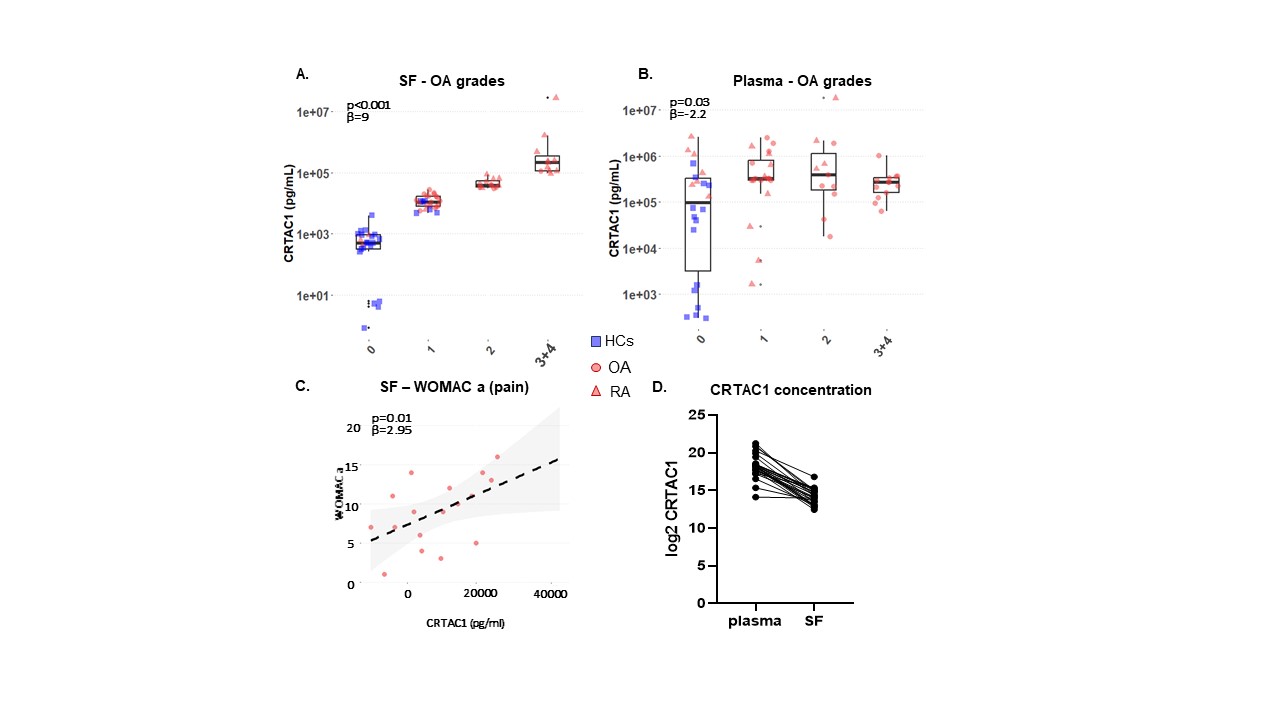Session Information
Date: Monday, November 13, 2023
Title: (0859–0885) Osteoarthritis & Joint Biology – Basic Science Poster
Session Type: Poster Session B
Session Time: 9:00AM-11:00AM
Background/Purpose: Cartilage acidic protein-1 (CRTAC1) has been recently considered a promising biomarker of osteoarthritis (OA) progression (1,2). The aim of this study is to compare CRTAC1 levels in paired synovial fluid (SF) and plasma samples from patients with knee OA and rheumatoid arthritis (RA) with unpaired samples from healthy controls (HCs). Secondly, to compare plasma CRTAC1 levels in patients with OA and patients with other inflammatory musculoskeletal diseases. Thirdly, to evaluate the association between CRTAC1 levels and OA severity.
Methods: Paired plasma and synovial fluid (SF) samples were obtained from patients with knee OA (n=26) and from RA patients who had knee effusion (n=19) and underwent therapeutic arthrocentesis. Control samples were obtained from HCs with post-traumatic knee effusion (n=25). Plasma samples were obtained from 67 HCs, 130 patients with OA (including knee, hip, and hand OA), 49 patients with RA, and 20 patients with axial spondyloarthritis (axSpA). CRTAC1 levels were measured using the CRTAC1 ELISA (Bio-Rad). Knee radiographs were evaluated by a blinded assessor using the Kellgren-Lawrence grading scale. Patients were examined by experienced rheumatologists and filled out the Visual Analog Scale (VAS) pain, the Western Ontario and McMaster Universities Arthritis Index (WOMAC), the AUStralian CANadian Osteoarthritis Hand Index (AUSCAN), and the Health Assessment Questionnaire (HAQ).
Results: CRTAC1 levels in SF and plasma were significantly higher in patients with OA compared to HCs (p< 0.001). Regression analysis showed a positive relationship between CRTAC1 levels in SF and OA severity (p< 0.001; β=9); however, systemic CRTAC1 levels showed the opposite trend (p=0.03, β=-2.2). We found a positive association between SF levels of CRTAC1 and WOMAC-A (p=0.01, β=2.95).In wider cohort, plasma CRTAC1 levels were higher in patients with OA compared to patients with RA, axSpA, and HCs (all p< 0.01). We found a negative association between systemic CRTAC1 levels and VAS pain (p=0.03, β=-2.3) in OA. There were no significant differences in CRTAC1 levels among OA subtypes.
Conclusion: This study provides the first evidence of a distinct local and systemic profile of CRTAC1 in patients with knee OA. CRTAC1 levels in synovial fluid may better reflect pain and severity of joint involvement compared to its plasma counterparts, which likely reflect other physiological and pathophysiological processes.
Acknowledgement: Supported by GAUK-266523, MHCR 023728
Reference: (1) Styrkarsdottir U, et al. The CRTAC1 Protein in Plasma Is Associated With Osteoarthritis and Predicts Progression to Joint Replacement: A Large-Scale Proteomics Scan in Iceland. Arthritis Rheumatol. 2021;73(11):2025-2034. doi:10.1002/art.41793 (2) Szilagyi IA, et al. Plasma proteomics identifies CRTAC1 as a biomarker for osteoarthritis severity and progression. Rheumatology (Oxford). 2023;62(3):1286-1295. doi:10.1093/rheumatology/keac415
To cite this abstract in AMA style:
Pekacova A, Baloun J, Navratilova A, Ondrejcakova L, Zborovjanova J, Fulin P, Ballay R, Tomcik M, Senolt L. Role of CRTAC1 as a Biomarker of Osteoarthritis [abstract]. Arthritis Rheumatol. 2023; 75 (suppl 9). https://acrabstracts.org/abstract/role-of-crtac1-as-a-biomarker-of-osteoarthritis/. Accessed .« Back to ACR Convergence 2023
ACR Meeting Abstracts - https://acrabstracts.org/abstract/role-of-crtac1-as-a-biomarker-of-osteoarthritis/


